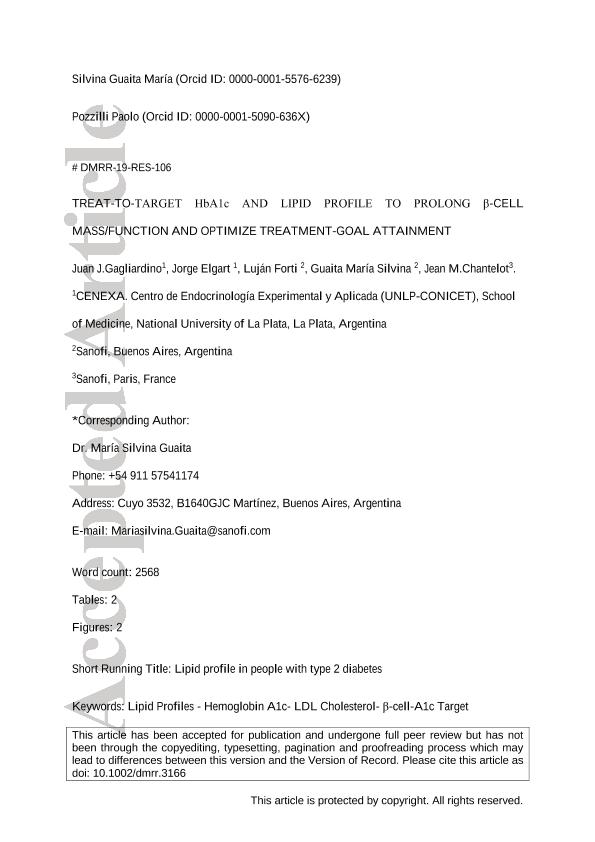Artículo
Treat-to-target HbA1c and lipid profile to prolong β-cell mass/function and optimize treatment goal attainment
Gagliardino, Juan Jose ; Elgart, Jorge Federico
; Elgart, Jorge Federico ; Forti, Luján; Guaita, María Silvina; Chantelot, Jean M.
; Forti, Luján; Guaita, María Silvina; Chantelot, Jean M.
 ; Elgart, Jorge Federico
; Elgart, Jorge Federico ; Forti, Luján; Guaita, María Silvina; Chantelot, Jean M.
; Forti, Luján; Guaita, María Silvina; Chantelot, Jean M.
Fecha de publicación:
05/2019
Editorial:
John Wiley & Sons Ltd
Revista:
Diabetes/metabolism Research and Reviews
ISSN:
1520-7552
Idioma:
Inglés
Tipo de recurso:
Artículo publicado
Clasificación temática:
Resumen
Background: To evaluate the relation between different serum lipid fractions and other known barriers to attain the HbA1c ≤ 7.0% (53 mmol/mol) target. Methods: Data on 2719 patients with type 2 diabetes were collected from the five waves of the International Diabetes Mellitus Practice Study implemented in Argentina (2006 to 2012) including demographic/socioeconomic profile, clinical, metabolic (HbA1c and serum lipids) data, and treatment type and also, percentage of treatment goal attainment. Descriptive statistical analyses included ANOVA, χ2 test, and Fisher exact test and univariate and multivariate logistic regression analyses, which identified predictive factors for HbA1c ≤ 7% (53 mmol/mol). Results: The average age was 63 years, primary/secondary education, health insurance, 10‐year type 2 diabetes duration, most associated with cardiovascular risk factors and some microvascular/macrovascular complications; 94.5% received antihyperglycaemic drugs. Percentage of people on target: HbA1c 51.2%, blood pressure 23.5%, total cholesterol 62.6%, low‐density lipoprotein (LDL) cholesterol 38.9%, and triglycerides 61.1%. HbA1c on target depended markedly on treatment type: more of those treated with lifestyle changes and significantly fewer of those receiving insulin. Only 4.1% had all parameters simultaneously on target. Multivariate logistic regression analyses showed that achieving HbA1c ≤ 7.0% (53 mmol/mol) was associated with higher educational level, shorter diabetes duration, and having reached goals for LDL cholesterol and triglycerides, whereas opposite results were obtained with insulin treatment and longer diabetes duration. Conclusions: High LDL cholesterol and triglyceride levels simultaneously potentiate development/progression of chronic complications, exerting this effect in the long term by decreasing β‐cell mass/function, thereby making it more difficult to reach HbA1c values able to prevent complications.
Palabras clave:
HAEMOGLOBIN A1C
,
LDL CHOLESTEROL
,
LIPID PROFILES
,
Β CELL
,
Β-CELL-A1C TARGET
Archivos asociados
Licencia
Identificadores
Colecciones
Articulos(CENEXA)
Articulos de CENTRO DE ENDOCRINOLOGIA EXP.Y APLICADA (I)
Articulos de CENTRO DE ENDOCRINOLOGIA EXP.Y APLICADA (I)
Citación
Gagliardino, Juan Jose; Elgart, Jorge Federico; Forti, Luján; Guaita, María Silvina; Chantelot, Jean M.; Treat-to-target HbA1c and lipid profile to prolong β-cell mass/function and optimize treatment goal attainment; John Wiley & Sons Ltd; Diabetes/metabolism Research and Reviews; 35; 6; 5-2019; 1-7
Compartir
Altmétricas



